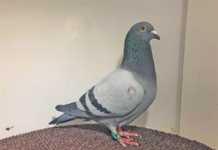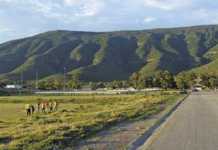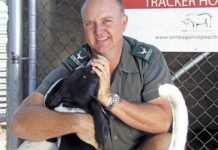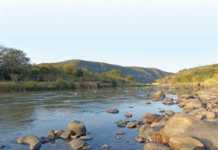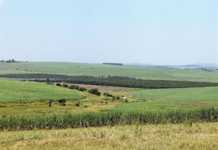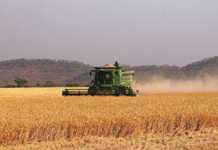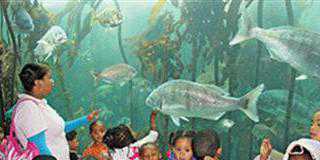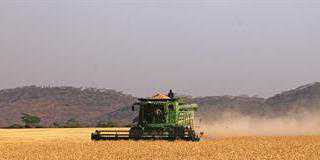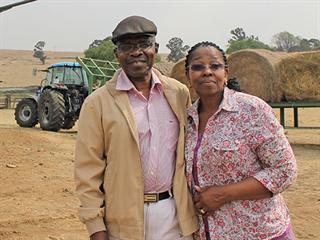
“We used to look forward to weekends, because that’s when we visited farms outside Johannesburg to admire other people’s cattle,” recalls Prof Lumkile Nkuhlu. Times have certainly changed. Today, the couple have their own farm, the 990ha mixed farming operation Denemark Cala Farm, outside Vrede in the Free State. And Lumkile has been named Grain SA’s Developing Grain Producer for 2013.
A former economic advisor to President Thabo Mbeki, Lumkile acknowledges that farming is in his blood. He grew up in rural Cala in the Eastern Cape, helping his father herd cattle and, during the school holidays, ploughing the lands, weeding and harvesting. His wife, Nondima, grew up on her father’s farm in King William’s Town. Lumkile temporarily lost interest in agriculture when he went to the University of Fort Hare, where he qualified as a chartered accountant. “Whenever I went home I seldom went near the cattle or the lands,” he remembers.
Things changed after Lumkile and Nondima moved to Johannesburg in the mid-1990s, where Lumkile was appointed chairperson of the Development Bank of South Africa.“We felt that we were missing the land,” he says. ”As we had no relatives in the rural areas close by, we found ourselves surrounded by concrete. We felt overwhelmed, and that’s when we started driving out into the countryside almost every weekend.”

Alfred Khoza, Mongezi Dlaza and Sifiso Radebe work full-time and stay on the farm. Mongezi is a student at Fort Cox College of Agriculture & Forestry and is doing experiential training on the farm.
Finding a farm
In 1998, the couple decided to buy a farm. “We started by looking for a farm back home near Cala,” explains Lumkile. ”We found one in Elliot, but then we started doubting the wisdom of owning a farm in the Eastern Cape while we were based in Johannesburg. Getting there would have required us to fly to East London and then hiring a car to get to the farm, more than an hour away.”
Nondima takes up the story: “It was while paging through Farmer’s Weekly that we came across this farm. The owner was selling the farm and its cattle and sheep as a going concern. We couldn’t afford all of the livestock, so we selected what we wanted. ”That was in 2000, and Lumkile and Nondima started off with about 600 mutton Merinos and 100 head of cattle. They also ploughed about 180ha for grain.
To add to their farming knowledge, the couple attended courses and read whatever literature they could get their hands on. They then passed on their knowledge to the workers on their farm, and also sent workers on courses. Today, the farm is managed by Lumkile and Nondima’s son Khaya and their nephew, Zola Nkuhlu.
Grain
For the past eight years, the Nkuhlus have planted just over 50ha to dryland soya beans and 90ha to dryland rainfed yellow and white maize annually. “We can plant up to 200ha, but limit it to about 150ha because of the high costs of grain production,” says Lumkile. “Seed and fertiliser are the two major inputs. We can do very little about the fertiliser price, but when it comes to soya beans, retaining seed for planting works for us.
We keep back about 3,75t of the harvested seed and use it for only two seasons, then buy new seed. Roundup Ready cultivars are resistant to Roundup herbicide, but we don’t retain seed and re-use it for very long, as it might not be effective anymore.” Re-using the seed has not affected his yields negatively. “We still have a yield of up to 1,5t/ha for soya bean,” he says.
The Nkuhlus keep half of the maize to use as animal feed on the farm and market the balance through Afgri. Lumkile admits that they have had some learning to do. “When we arrived here, we used some of the old farming methods from
the Eastern Cape,” he explains. Instead of using herbicides to control weeds, for example, they weeded manually. “This affected our maize yields badly, with average yield as low as 2,5t/ha,” notes Lumkile. Needless to say, since the Nkuhlus switched to using herbicides, maize yields have improved to up to 4t/ha.
The average rainfall in the Vrede area is about 650mm/year. Lumkile is thankful that they have not been affected by drought or other natural disasters.“The only problem so far has been runaway veld fires. But because of very efficient fire management in the district, these are stopped before causing too much damage,” he says.
Rotation and water supply
Cattle and sheep weaners are sold at auctions in Standerton, Mpumalanga. “When we cull some of the adult animals they’re also sold at auction,” says Lumkile. There are about 300 breeding ewes on the farm, and about 150 breeding cows.
The farm is divided into 10 camps of different sizes, all of which have water. “We have enough surface water in the form of a river and dams in the camps, but some are dependent on boreholes,” explains Lumkile.
Weaners, calves that have not yet weaned, dry cows and bulls are kept in separate camps. The rotation depends on the condition of the grass, with the cattle being kept in a camp for four to six weeks. But because the Nkuhlus’ eastern neighbour is a game farmer, and has wildebeest, rotation is crucial, as wildebeest are carriers of snotsiekte. One year they lost six cattle, including two stud bulls, to the disease. To avoid a recurrence, cattle are moved away from the camps on the eastern border during spring and autumn. “The cattle are brought back during the winter period, when there are fewer flies to transmit the disease,” adds Lumkile.

The farm and all its equipment was financed by the Nkuhlus’ life savings.
Breeding
For breeding, the ratio is at least one bull to 30 cows in a multi-sire breeding herd. And only bulls from reputable breeders are used. “We’re in the business of selling weaners, and quality bulls yield quality weaners,” says Lumkile. The bulls’ fertility is tested every year. Those that do not perform are culled. Bulls do not stay on the farm for more than four years. When a bull becomes troublesome, shows bad temperament or becomes too heavy, it is culled irrespective of the period it has been on the farm.
“A heavy bull becomes too lazy and doesn’t do its job,” notes Lumkile, adding that he does not use bulls bred on the farm for breeding purposes. Every second year, non-performing cows are also culled. “When we cull a cow, we look at its conception history, calving problems and age,” says Lumkile. We like to give cows a second chance, but if a cow doesn’t conceive for two consecutive seasons it’s culled.”Calves are weaned at seven months, when weighing at least 250kg. The Nkuhlus use their own heifers as replacements.
Diversification to improve cash flow
Two years ago, the Nkuhlus diversified by adding a piggery of about 70 breeding sows and a small broiler unit of 300 chickens per cycle. “We added the chickens and the piggery to counter the slow cash-flow from the cattle, sheep and grain production,” explains Lumkile. “Managing the chickens and the piggery well enables us to generate income more regularly.
He adds that they also wanted to create more jobs.
“For more than 10 years, we employed four people, but now have 15 permanent employees. We also take in students for experiential training on the farm. Because of my educational background, I’ve always wanted to do more to contribute by teaching and training. “My long-term goal is to start a training centre on the farm.“
Phone Nondima Nkuhlu on 082 880 1600.

